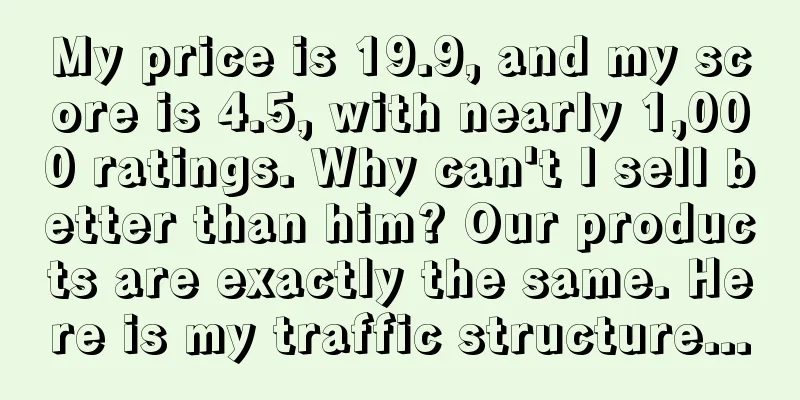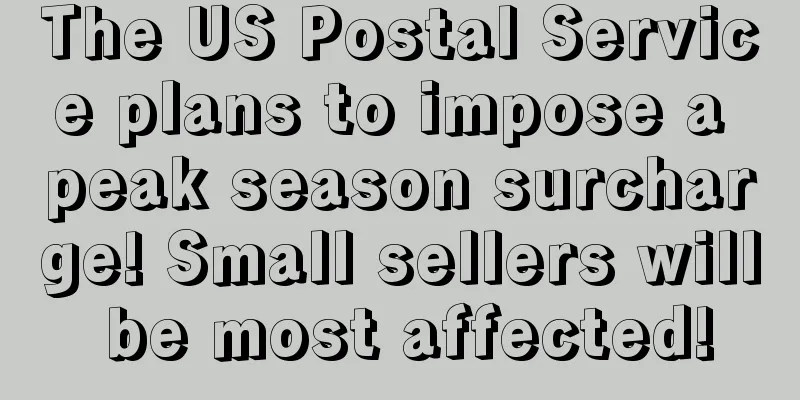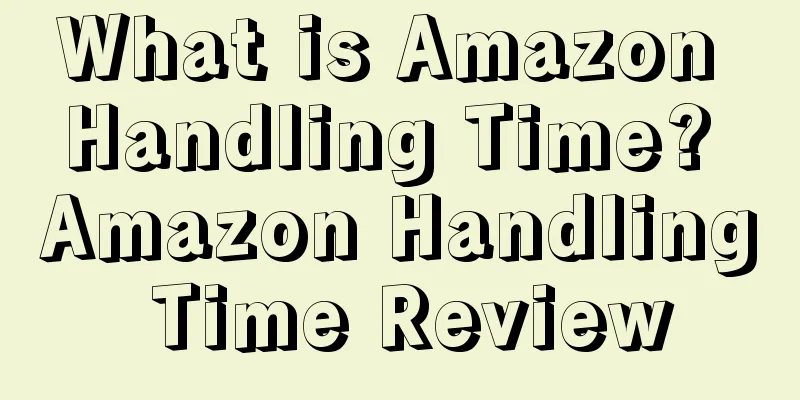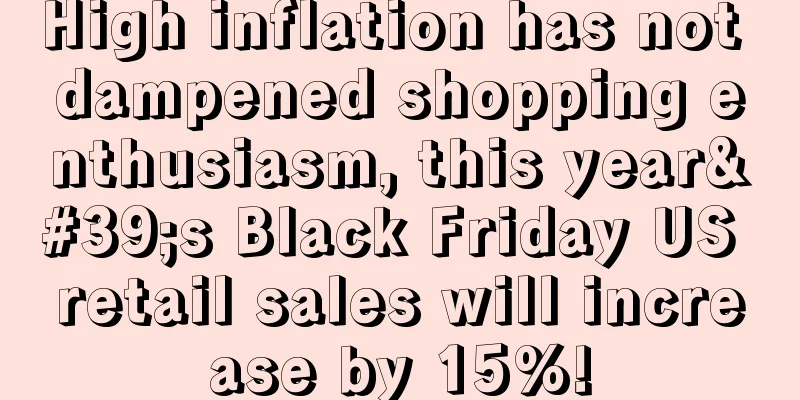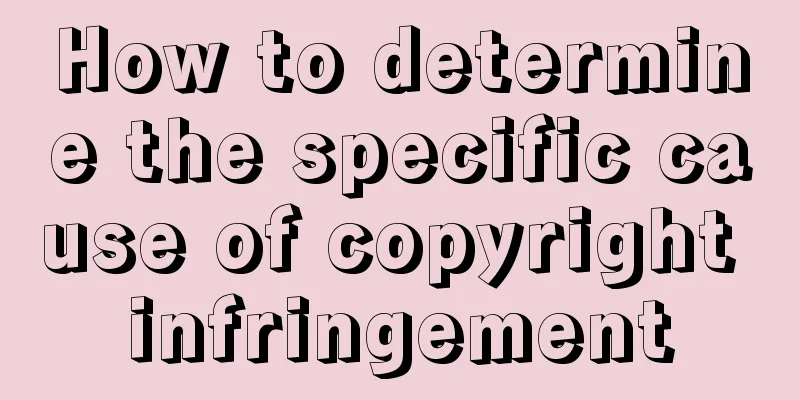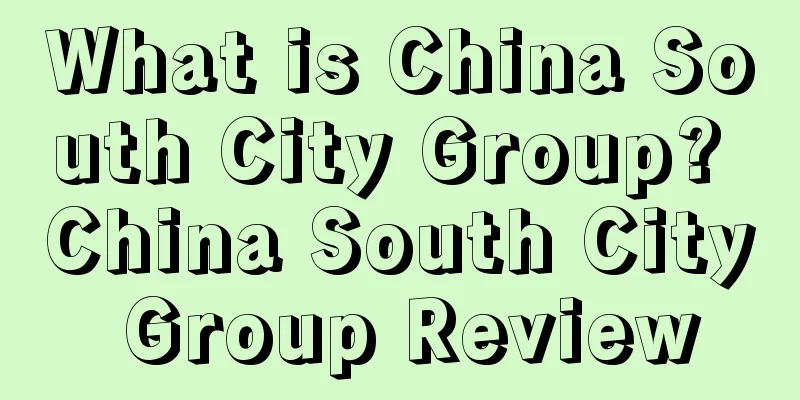|
Let me first talk about the basic situation of me and my competitors
My product: Price 19.99, BD price 16.99, 4.5 points , close to 1000 ratings
Competitor: Price 23.99, BD price 16.99, 4.1 points, 700 ratings
Our products are exactly the same, not private models. My products are basically BD for two weeks a month, and a 20% discount coupon is available for the other two weeks. Competitors also have BD for two weeks a month, and a 5-10% discount coupon is available for the other two weeks.
We are basically the two best-selling links for this product. Whether it is BD or not, his ranking is always slightly higher than mine. Of course, I can suppress him when I am BD, but under the same circumstances, his sales are always better than mine. I am very confused. Obviously, my price is cheaper, I have more ratings, and my score is also high, why can't my link sell better than his?
Advertising
1. I have layouts for automatic/manual precision, broad/SD similar products/SBV. The overall conversion rate is around 15%, advertising ACOS is around 25%, advertising accounts for around 10% of total sales, and advertising singles account for nearly 60%.
2. For the most relevant and precise words, my natural position is usually either in the first row or the second row, and the advertising position is basically in the first row of the homepage.
3. For the keywords with the largest traffic, my ads can usually reach the first row of the homepage, but the natural position is between the bottom of the first page and the top of the second page. However, the natural position of the competitor is much higher than mine for this keyword. Two years ago, my product was ranked 1-2 for this keyword, and the natural order ratio was 70%-80%. I don’t know what part of the link was adjusted in the past two years, which caused the natural position of this keyword to drop, and I can’t get it up no matter how hard I try.
In terms of traffic, I used software and found that the structures of our advertising traffic and natural traffic are completely different.
My traffic structure is as follows:
The traffic structure of competing products is as follows:
It can be seen that I am the only one who spends a lot of money on advertising, while his traffic is almost all natural, but my orders are not as many as his. So I want to ask why, my price is cheaper, my ratings are higher, and my score is high for the same product, and I spend a lot of money on advertising, but my orders are not as many as his, and my profit margin is definitely not as high as his, what should I do?
1. Is it because of my keyword embedding that the system cannot recognize my link as well as it does? Is it because my natural traffic is not as good as it is?
2. Or is it that my pictures are not as good as his? That leads to low click-through rate and conversion rate, so the system does not give me a natural ranking? But we have both been selling old products for a long time, and we have A+ pictures. When his price, ratings, and scores are not as good as mine, how big of a difference can the conversion rate be to cause such a big difference in my natural traffic?
Is there any expert who can teach me how to improve this natural traffic problem? Should I adjust the ads, titles, pictures or other aspects so that I can reach the level of links?
"Wonderful Reply"
Anonymous user Traffic words: refers to the keywords that buyers enter through the search box, that is, buyers may find your products through the search keywords, which can trigger the display of related products. In general, when buyers search for a certain keyword, your product will appear, which is your traffic word.
Let's go back to the formula sales = traffic * conversion. Either the other party has more traffic than you, or the other party has more conversion than you. Conversion generally does not form a big difference in magnitude. Generally, it is easier to widen the gap by manipulating traffic. Combined with your traffic analysis of competitors in the article, you can also preliminarily judge that the reason why the other party's traffic is higher than yours is that the other party's traffic words are better than yours.
The other party has two core points: one is that they have more overall traffic words than you, and the other is that they have more natural traffic words than you (free traffic).
So how to increase traffic words?
I believe everyone knows that the number of traffic words is proportional to the size of product traffic. However, many people have a misunderstanding that links with more traffic words must have higher traffic than links with fewer traffic words. Product A has more traffic words, and product B has fewer traffic words. This only proves that the source of traffic words of A is more than that of B, but it cannot prove that the traffic of product A > the traffic of product B.
Here are two examples:
1. Product A has 1 traffic word, and the brand analysis (ABA) ranking is 1000. Product B has 10 traffic words, and the brand analysis (ABA) ranking is 10w+. The search volume of A will be much greater than the search volume of B keywords, so the traffic of A is greater. (Here only the search volume is considered, and the keyword position is not considered for the time being)
2. For the same keyword a1, product A uses broad matching, which can match many a1-related traffic words. These matched traffic words are ranked very low; product B uses precise matching, and keyword a1 is ranked very high. Although B has few traffic words, its traffic is generally larger than A.
The key to increasing traffic words is to embed keywords in listings. Copywriting, pictures, QA, etc. can all embed keywords, which will affect the basic inclusion of listings. Secondly, it is necessary to add broad-matching type ads, with the SP+SB+SBV advertising framework, select "Broad/Phrase" for the delivery type, and control the ad position (preferably in the first three pages), so that various traffic words can be matched to the greatest extent. Finally, for expanding traffic words, don't forget the invisible weapon of product delivery. This delivery can match more traffic words. For the specific logical interpretation, please refer to this article by S*F >>>Subverting cognition: A new discovery of ASIN positioning advertising: https://mp.weixin.qq.com/s/sk_JFpF9MbI-mxmFUa0qdg
Although traffic words are directly proportional to traffic, we should pay more attention to product keyword rankings than traffic words. Otherwise, there will be a situation where there are many traffic words but the traffic is not increasing. At the same time, it is also answering the second question, how to increase natural traffic---improve the ranking of natural keywords.
Regarding improving keyword rankings, the most common method is to use S-order to brush this keyword + advertising to be precise. You can decide how many orders to get based on the competition in the category (for example, if this word has 10 orders, it can be on the homepage. At this time, you can increase the ratio by at least 20-50% and maintain it for more than a week). The most important thing about this method is to have enough orders and sustainability. If you get more orders for this word, the ranking will naturally go up quickly.
You can also refer to this article by SellerSprite on how to get keywords on the homepage: You can also refer to this article by **SellerSprite on how to get keywords on the homepage: https://www.sellersprite.com/v3/knowledge/feature/how-to-understand-spr
If you can't get promoted by big keywords, then from the perspective of traffic logic. Assuming that a big keyword can contribute 100 traffic a day, then logically you can do 5 keywords that can contribute 20 traffic a day, and the promotion difficulty is not that great. It should be noted that for most categories, if you want to become a top seller, you must use big keywords later, because small keywords may not be enough for you to become a top seller.
For the analysis of traffic words, you can read this article: https://www.wearesellers.com/question/89907
Anonymous user 1. Is it because of my keyword embedding that the system cannot recognize my link as well as it does? Is it because my natural traffic is not as good as it is?
If there is keyword embedding, you can see it from your own automatic advertising. Download the search term report of automatic advertising and check the keywords related to your product. If it is irrelevant to your product, you need to optimize your links. Amazon is a platform that focuses on links. If you sell well and have good conversion, it will give you more traffic. If you do not convert well, the traffic will decrease relatively.
2. Or is it that my pictures are not as good as his? That leads to low click-through rate and conversion rate, so the system does not give me a natural ranking? But we have both been selling old products for a long time, and we have A+ pictures. When his price, ratings, and scores are not as good as mine, how big of a difference can the conversion rate be to cause such a big difference in my natural traffic?
I have seen from the table and analysis provided by the questioner that the factors of the listing itself should not have much impact on your conversion, and the main factor is advertising. Your advertising conversion is very good, but you have more advertising orders, and the ratio of advertising orders to organic orders is 6:4, which leads to your organic orders not being as many as your competitors.
Moreover, your organic position is lower than that of your competitors. Most of your competitors are at the front of the homepage, while yours can only be on the second page or at the bottom of the first page. Only your advertisement is on the homepage, which results in customers clicking on your advertisement instead of clicking on the organic position to complete the transaction. If you reduce your advertising costs, I believe your overall orders will also decrease. Because before your organic position is on the homepage, it is impossible to achieve an organic order ratio greater than the advertising order ratio.
The reason why you were able to get better orders than your competitors before: the most important point is that your organic position is on the homepage, so the organic order: advertising order = 3:7 or 2:8. This is a very good order ratio. However, because your organic position has dropped, your advertising orders have increased and your organic orders have decreased.
The topic owner needs to spend a lot of budget to push his keywords to the homepage. The specific method is as follows:
Find the keywords with the largest traffic and the strongest relevance, KW1 and KW2. The budget starts at $10 (note that if the subject is good at converting under the keyword, you can add more budget), bid the suggested bid or 1.5 times the suggested bid as the initial bid (the bid does not have to be based on this bid, if you are an old product, you can lower the bid to test your own ad position), the bidding strategy is fixed, the initial bonus for the first line is about 30%, so that the ad position is prioritized to the top of the search results.
If you can't spend it all, raise the bid by about 20% to find a suitable bid. Spend the budget for 10 clicks every day for a week. In this way, the budget for KW1 and KW2 may be increased to about 50-80 US dollars per day; the purpose of spending the budget every day is to make the system think that our products are more popular and push more traffic to us; the budget is increased for a week in a row to keep the budget above 50, so that there will be more orders under the keyword. Influence the rise of keyword ranking.
When both of your keywords are naturally promoted on the homepage, you can reduce the advertising budget and advertising space for the keyword, and then promote other keywords. Push other keywords to the homepage, and gradually push more keywords to the homepage naturally, so that you can have more natural orders.
Note: Sometimes some keywords cannot be put on the homepage no matter how hard you try. In this case, you need to change keywords. Because under different keywords, the competitors on the first page may be strong or weak, or all the product links on the first page may be very strong. You can't beat the page optimization no matter how you optimize it. At this time, you can only change direction and find the "soft persimmon" on the first page of keywords to pick and take it. Use third-party software such as SellerSprite to reverse check the keywords of competitors.
You also need to participate in activities: on-site and off-site activities or coupons for discounts
Regarding flash sales, it is better to do it after confirming the position of your advertising keywords, because in brand analysis, each keyword has 3 TOP links, and the shared click-through rate and shared conversion rate are the best rankings. So at this point, our goal is that the product can enter the TOP3 position of a second-level keyword (the traffic is one level lower than the big word), because flash sales can definitely increase the conversion rate.
Why do you need to position the keywords in the ads appropriately? Because if you want your product to have a good conversion rate, you also need people to see it at the right time and in the right place. Otherwise, even if you sell it for $1, no one will see it and there will still be no conversion. Once you find a keyword that can hit the TOP3 position and enter the brand analysis list, you can follow this method to find other keywords and gradually break through the natural position. Eventually, you will reach a higher natural position for the keywords, and achieve a higher product traffic and order volume than the advertising traffic and order volume.
The second is the traffic problem. Looking at the traffic score, your traffic is much less than that of your competitors. You also need to solve your own traffic problem and enable more ad matching methods and ad combinations.
Broad phrase matching can increase traffic, but you need to use negative keywords in this process, otherwise if the keywords are not accurate, it will affect the conversion of your entire link.
1. Open broad/phrase match for big word A, and focus on the top search position for placement. Try to fill in the bid value in the bid range of the top search, or the bid range of other search positions (this can be determined by the data of placement running for a period of time). The bidding method is determined according to your actual exposure effect. If the exposure and clicks are stable, fixed bidding is fine. If the exposure is unstable (low, difficult to run data), you can use up and down to leverage the data in the early stage. In the end, most of the clicks of this ad group are concentrated in the top search position or other search positions. If the big word A is also targeted and the matching method is broad/phrase, on the one hand, it can meet some of the so-called "small words running big words" needs. On the other hand, for the same big word top position, the bid cost of phrase/broad match is lower than that of precise match.
2. Category ads: By collecting information about the same products with high keyword relevance, and summarizing their brands, comments, prices and other information, when placing category ads, select this information in detail. The logic of placement is the same as that of ASIN ads. The disadvantage of category ads is the same as that of ASIN ads, which cannot track data for specific keywords. But the best thing about it is that the bid requirements can be very low for the top search positions. It is possible to stabilize the top search position by spending 0.X dollars, which is very cost-effective. Because there are not many sellers who use category ads to run the top search positions, there is less competition for advertisers.
3. Video ads have a better conversion rate, so you can start video ads. The precise matching in video ads is also very helpful for the promotion of keywords!
Note: Because your link is old, you can negate the keywords in the original old advertising campaign, but don’t make too many adjustments. (You can’t reduce the budget of the old advertising campaign, nor can you reduce the single bid. If you do, the advertising traffic of this link will decrease, the advertising orders will also decrease, and the natural orders will also decrease! Therefore, the old advertising campaign does not need to be changed significantly, just negate the spam keywords!)
In the keyword ads you reopened, if the orders are good, you can gradually reduce the keyword bids in the old ads, and later you can gradually close the old advertising activities.
It should be so - God helps those who help themselves According to your description, the reasons why the ranking and sales volume are higher than yours are:
1. For keywords with high traffic volume, your competitors’ traffic share is higher than yours. This is very important and directly affects the difference in the share of natural search traffic between you and your competitors.
2. The natural weight of the competitor is much higher than yours, and your orders are more dependent on advertising expenditures and advertising slots. In summary, your comprehensive natural weight/traffic is like the competitor.
My suggestions are:
1. Keyword embedding is just one of them. You can use it as a screening factor at most. Compare the titles, bullet points, pictures, attribute information, and search terms of the two. (Many third parties have this function, including Baidu.)
2. As for pictures, make sure your marketing expression method is as good as the other party’s by comparison, and your selling point content output is also stronger than the other party.
3. The traffic structure analysis is not enough, including natural search traffic, SP advertising traffic, SB advertising traffic, AC recommended traffic, other recommended traffic, off-site traffic, etc.
Why do we need to analyze SP and SB separately? Because SP generally helps natural weight better than other advertising types (SB SD). Referral traffic is a supplement to natural search traffic.
4. If you want to promote keyword weight, SP precise matching is indispensable. Set a promotion period (half a month or a month). Through deals or coupons, focus on increasing the conversion rate and number of conversions of your links under big words. Only when the performance data is better than that of the opponent for a period of time can it promote the growth of keyword rankings.
A more reasonable and balanced advertising structure (focus on different advertising campaigns at different stages)
Search traffic:
Precise matching - core words (main promoted words), the purpose is to lock in core precise traffic.
Broad, phrase matching - core words (mainly recommended words), further capture the marginal traffic of core words. Whether to place ads on other non-core words (long-tail words, related words, etc.) depends on the proportion of advertising costs and the characteristics of the category.
Note: The above ad positions are mainly located on the search page.
Related traffic:
ASIN advertising - strong competitors (where you have an advantage) directly run advertising spots on product details pages.
ASIN advertising - weak competitors (those where you don’t have an advantage) go directly to the top search position. Since you don’t have an advantage, it’s best to complete the competition comparison on the search page to avoid wasting invalid clicks.
Category advertising - refine the brand, price, and rating. This type of advertising has a relatively low cost and focuses on attracting traffic with conversion as a secondary purpose.
SD——strong competitor, CPC bidding, and rush for conversion.
SD——weak competitor, VCPM, grabbing exposure.
Marketing exposure:
SB——Brand
SBV – Increase the click-through rate and interaction rate of listings on search pages
SDV - Enhanced detail page ad placement
Home page traffic, off-site traffic:
SD — contextual matching (no refinement)
SDV - No detailed delivery
Do the included analysis:
Automatic ads - close and broad: matching the listing content Automatic ads - same style and complementary: matching product type matching
Based on the above matching results, placement analyzes the performance differences of the product in different locations at this stage.
Forum related posts and attachments for keyword ranking can also be referenced:
https://www.wearesellers.com/question/68973
https://www.wearesellers.com/question/57949
https://www.wearesellers.com/question/50247
https://www.wearesellers.com/question/47647
https://www.wearesellers.com/question/77351
Anonymous user 1. When you mentioned the issue of keyword embedding, it is not clear whether your keyword embedding is consistent with that of your competitors. You can first compare the similarities and differences between your keyword embedding and that of your competitors. Check for omissions and make small-scale updates. However, we generally do not update the keywords embedded in the pages of old products, fearing that it will damage the original weight of the old keywords.
2. You also said that your pictures seem to be better than others. You can check the advantages of the product mentioned by customers on the competitor's page, and then check whether the page has magnified the promotion of these advantages. Have you not taken this into consideration? Have you made use of other traffic ports? Check whether bundle, A+, post, etc. have been supplemented.
3. For natural traffic, you should check the related traffic first. Also, have you compared the natural traffic of your competitors and which keywords have the biggest difference in natural traffic? If the traffic keywords with absolute advantage are eaten up, do you have the opportunity to rely on advertising to support it? Or you can supplement it with other peripheral general traffic. Generally, when we make old products, we don’t go to the core traffic later, because it has almost run out. We will test some peripheral general traffic keywords to attract orders for Tuolu.
Hope this helps!
Small business operation Hello, OP, you are too anxious. After reading your description, I feel I can give you the following suggestions. Welcome to discuss
1. First of all, you may have been listed at the same time. You have advantages in price, evaluation and score, but you still can't sell as well as Xiyou. Xiyou's comprehensive score is 146 and his is 600. The traffic difference here is 3 to 4 times, and the overall traffic is low. You can use Xiyou to check his keyword traffic structure, and then compare it with your own traffic structure to see which specific words are different, focus on them, and focus on advertising layout. You can directly hit his natural position through fixed positioning to compete with him.
2. ASIN targeting ads - accurately target your competitor's ASIN, hit their vocabulary, hit their details page. SD-content targeting. Directly target your competitor. Because you have advantages in all aspects, you can compete directly with them and grab their traffic.
3. If the competitor's products are all organic, you should consider whether they are brushing free review orders. They are holding back the traffic from organic positions, or diverting traffic through off-site channels (independent sites, TK, etc.). You can check on various software and search on Google. Because you need advertising to deal with it, they are worse than you in everything. It is unreasonable.
4. If you start with the listing, observe whether the selling points you and your competitors display are the same. Where is the gap? What do you need to improve? Analyze each picture one by one to see what is different in your expression, and optimize and modify it in a targeted manner, because your products are the same. Don't change the title, you can change the five A+ points as much as you want. Show your advantages, or if you think your competitor's product is good, you can imitate it. Don't lose at the listing level first. Then slowly conquer it at the traffic level.
jackson911 It was a bit like my situation. I tried all kinds of advertising and budgeting for the core word, but I couldn't surpass the competitor (I didn't run any ads for this word either). The competitor was always in the first place, and mine was always jumping between the third and fourth rows. Later, I just tried my best and gradually reduced the bid and budget for the core word. The natural position gradually stabilized in the second row, but it still couldn't shake his natural position. Although the natural position was stable in the second row, the number of orders was 20% to 30% less than when I was spending a lot of money on advertising before, and the advertising fee was also reduced by about 20% to 30%.
Overall, due to the reduction in advertising fees, although my order volume has decreased, my net profit is much better than before when the order volume was high. So now I accept my position. It is better to take the ranking than to compete for it.
|
